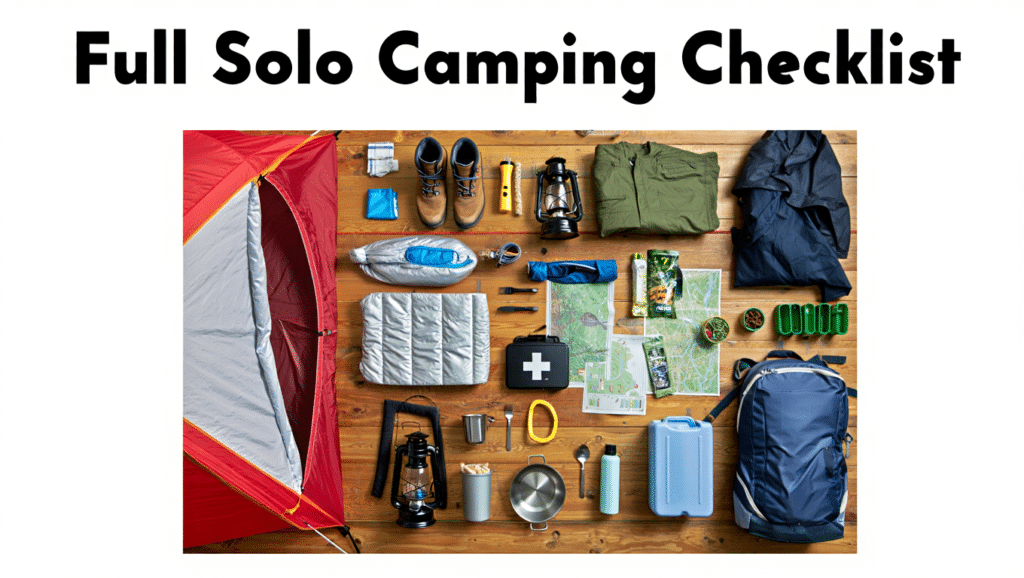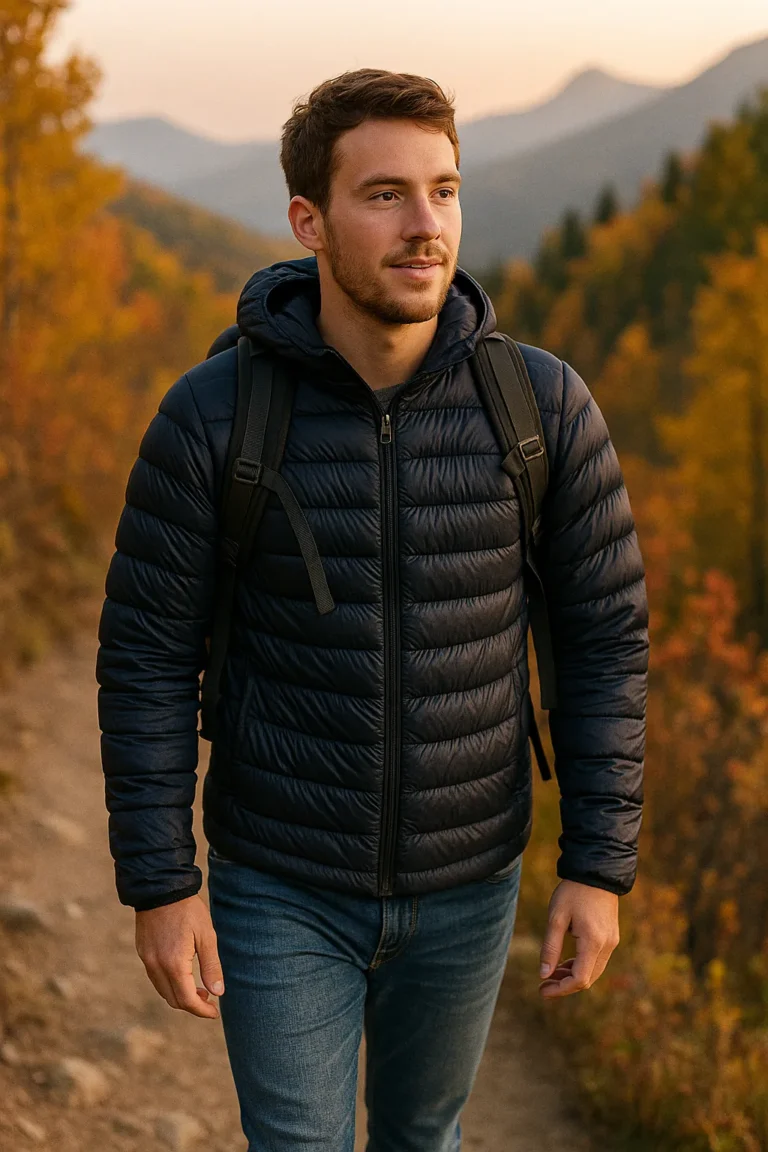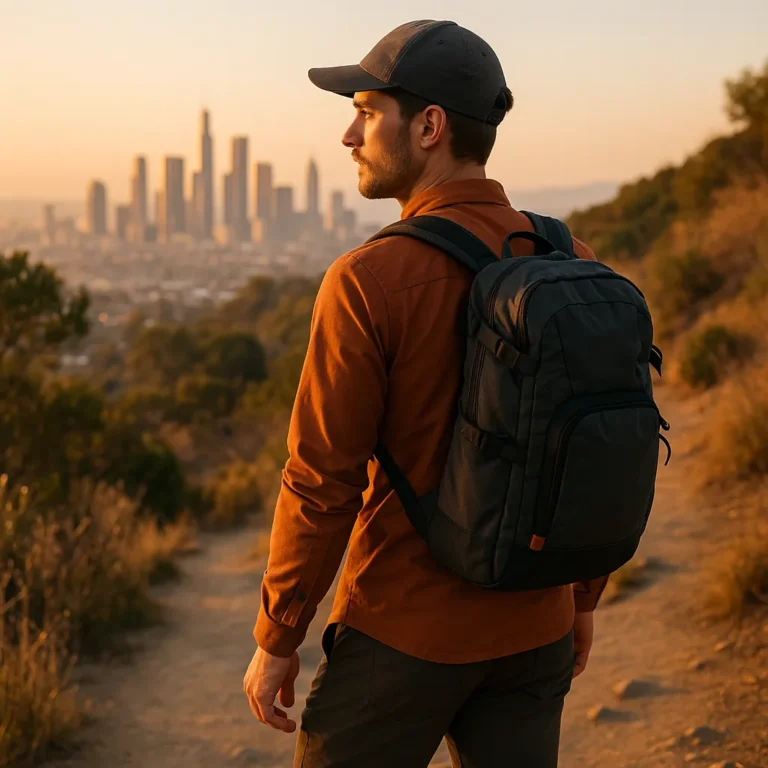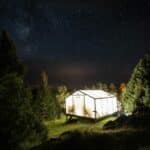Introduction
Solo camping is one of the most rewarding outdoor experiences you can have. It’s an opportunity to test your skills, enjoy true solitude, and reconnect with nature on your terms. But camping alone also means there’s no one else to rely on if something goes wrong.
The right preparation is key—having exactly what you need, knowing how to use your gear, and understanding how to handle unexpected situations can turn a daunting first trip into an unforgettable adventure.
Whether you’re a first-timer stepping into the wilderness or an experienced backpacker aiming to refine your gear list, this Solo Camping Checklist covers everything you need to stay safe, comfortable, and self-sufficient on the trail.
Let’s dive into the essentials!

Must-Have Essentials
When you’re camping solo, certain gear isn’t just convenient—it’s absolutely essential. Here’s a quick-reference checklist of the most critical items you should always carry to ensure safety and comfort on your solo adventures:
- Reliable Shelter: A lightweight, weatherproof tent or breathable bivy sack. Protects you from wind, rain, and insects.
- Sleeping Bag (Seasonal): Provides necessary warmth and insulation tailored to your camping conditions.
- Stove & Fuel: Compact cooking setup ensures hot meals and safe drinking water.
- Water Filtration System: Essential for safely purifying water from natural sources.
- Navigation Tools (Map & Compass/GPS): Crucial for keeping you oriented and safely on track.
- First Aid Kit: Stocked with essentials like antiseptics, bandages, and medications.
- Headlamp & Extra Batteries: Ensures visibility in the dark, freeing up both hands.
- Whistle: Lightweight emergency signaling tool that can be heard far away.
- Knife or Multitool: Versatile for cooking, repairs, and emergency use.
These essentials form the backbone of any successful solo camping trip. Never compromise on these basics, even when going ultralight.
Full Solo Camping Checklist
Here’s a detailed breakdown of all the gear you’ll need for a safe, comfortable, and enjoyable solo camping experience. This comprehensive list will ensure you’re prepared for just about anything.
Shelter & Sleep System
Your shelter and sleep setup determine your comfort and safety overnight. Even minimalist campers should prioritize these:
- Tent or Bivy Sack:
- Lightweight, waterproof, wind-resistant
- Easy and quick to set up solo
- Breathable materials to minimize condensation
- Sleeping Bag:
- Temperature-rated for the season and expected weather
- Consider a hooded bag for additional warmth
- Sleeping Pad:
- Essential insulation from cold ground
- Choose inflatable pads for comfort or foam for rugged reliability
- Pillow (optional):
- Lightweight inflatable pillow or use rolled-up clothing for comfort
- Tent Repair Kit:
- Small patch kit, duct tape, and pole splint to quickly fix unexpected damage
- Groundsheet or Footprint:
- Protects tent floor from moisture, sharp rocks, and dirt, extending its life
- Tent Mallet (optional):
- Handy for driving tent stakes into hard or rocky ground—especially useful in solo setups where you don’t want to waste energy.
Cooking & Water
Eating and staying hydrated properly is critical, especially when you’re on your own. Here’s the gear you need to keep things simple, safe, and satisfying:
- Food:
- Lightweight, high-calorie options (freeze-dried meals, dehydrated foods, nuts, dried fruits, energy bars)
- Simple preparation—just add boiling water or ready-to-eat snacks
- Water Filtration System:
- Reliable water filter, purification tablets, or both
- Essential for safely drinking from natural water sources
- Water Storage:
- Reusable water bottle or hydration reservoir (1–2 liters minimum)
- Portable Stove:
- Compact, lightweight stove (gas canister or liquid fuel)
- Quick boiling capability for efficiency
- Fuel:
- Adequate supply for the duration of your trip (plus extra in case of delays)
- Cookware:
- Lightweight pot with lid (ideal for boiling water, cooking meals)
- Mug/Cup:
- Lightweight, heat-resistant metal or durable plastic mug for drinks and soups
- Utensils:
- Compact spork or spoon-and-fork set; simple, durable, and multipurpose
- Lighter & Matches:
- Waterproof matches or reliable lighter in waterproof container
- Carry backups for added safety
- Small Trash Bag:
- Keep waste neatly packed, protecting the environment and wildlife
Clothing (Layered System)
Dressing in layers is the key to comfort and safety when solo camping. This approach allows you to quickly adapt to changing weather conditions and stay warm, dry, and protected:
- Base Layer (Thermal Underwear):
- Moisture-wicking top and bottom to keep you dry and warm
- Insulation Layer:
- Fleece jacket, lightweight down jacket, or insulated vest for added warmth
- Waterproof Shell (Jacket & Pants):
- Lightweight, breathable, waterproof gear to protect from rain and wind
- Hat & Gloves:
- Warm hat (wool or synthetic)
- Gloves—waterproof or insulating, depending on season and climate
- Socks:
- Primary pair plus at least one backup set (merino wool or synthetic, quick-drying)
- Hiking Boots or Trail Shoes:
- Comfortable, properly broken-in footwear suited to terrain and weather conditions
- Rain Gaiters or Rain Pants (optional but recommended):
- Extra protection from mud, water, and debris
- Camp Shoes or Sandals (optional):
- Lightweight shoes to rest your feet around camp
- Rain Boots (optional):
- Ideal for muddy terrain, river crossings, or persistently wet weather. Keep your feet dry and warm when conditions get sloppy.
Remember to always check the weather forecast and pack accordingly. Even if conditions look perfect, be prepared for unexpected changes.
Navigation & Safety
When camping alone, you’re solely responsible for navigation and your own safety. Here’s everything you need to ensure you can confidently find your way and manage emergencies:
- Map (waterproof or laminated):
- Detailed map of the area you’re exploring, kept in a waterproof sleeve.
- Compass:
- Reliable, easy-to-use compass for basic orientation and navigation.
- GPS Device (optional but recommended):
- Portable GPS unit or offline GPS app with pre-downloaded maps on your smartphone.
- Extra batteries or power bank for longer trips.
- Headlamp or Flashlight:
- Hands-free headlamp with spare batteries for night visibility.
- Whistle:
- Lightweight and loud—essential for signaling help if you’re lost or injured.
- Knife or Multitool:
- Compact tool with blade, scissors, screwdriver, and other essentials for repairs and emergencies.
- First Aid Kit:
- Includes antiseptic wipes, bandages, pain relievers, anti-chafe balm, blister tape, antihistamines, anti-diarrhea tablets, gauze pads, Band-Aids, and any personal medication.
- Prevention and comfort matter just as much as treatment—especially when you’re out there alone.
- Insect Repellent:
- Effective bug spray or lotion suitable for local insect conditions.
- Sunscreen:
- High-SPF, sweat-resistant formula to protect exposed skin from sunburn.
- Personal ID and Emergency Contacts Card:
- Laminated card with your identification details, allergies, medical conditions, and emergency contacts.
- Personal Locator Beacon (optional):
- Recommended if camping in remote locations—allows quick rescue in severe emergencies.
- Flashlight (as backup to headlamp):
- A small backup flashlight ensures you’re never left in the dark if your headlamp fails or batteries run out unexpectedly.
When traveling solo, thorough preparation isn’t just helpful—it’s critical. Never underestimate the value of reliable safety gear and knowledge of how to use it.
Repair & Tools
Gear occasionally fails, especially when you least expect it. A small but carefully chosen repair kit can make the difference between a minor inconvenience and a serious problem on a solo camping trip:
- Needle & Thread:
- For quick clothing or gear fixes (use strong nylon thread or dental floss).
- Universal Gear Glue:
- Small tube of multipurpose adhesive to patch gear, tents, and footwear.
- Tent Patches:
- Easy-to-use adhesive patches to repair holes or tears quickly.
- Multitool (if not already packed):
- Should include pliers, scissors, screwdriver, and other useful attachments.
- Paracord (15–20 ft):
- Versatile for fixing gear, rigging shelters, hanging food, and emergency situations.
- Duct Tape (small roll):
- Highly versatile, excellent for quick fixes on almost anything—from torn gear to footwear.
- Blister Tape:
- Essential for preventing and treating hot spots during long hikes. Pre-cut or carry a small roll.
Keep your repair kit compact and organized. Small items like these can solve big problems when you’re out there alone.
Personal Hygiene
When you’re camping solo, maintaining basic hygiene isn’t just about comfort—it also helps prevent illnesses and keeps your spirits high on longer trips:
- Biodegradable Soap:
- Multipurpose for washing hands, dishes, and personal hygiene; environmentally safe.
- Toothbrush & Toothpaste:
- Travel-size toothbrush and toothpaste for daily dental hygiene.
- Toilet Paper:
- Kept in a waterproof bag; bring extra for emergencies.
- Wet Wipes:
- Quick and easy way to freshen up without water; pack out used wipes.
- Microfiber Towel:
- Lightweight, quick-drying, ideal for personal washing or drying gear.
- Hand Sanitizer:
- Small bottle for quick sanitation before eating or after toilet use.
- Toilet Trowel:
- Leave No Trace essential—dig a proper cathole for responsible waste disposal in remote areas.
- Floss (optional):
- Lightweight and multipurpose—great for hygiene and even emergency gear repairs in a pinch.
Keeping hygiene gear compact but thorough can significantly improve your comfort and morale during solo camping trips.
Miscellaneous
These additional items may seem small, but they can greatly enhance your solo camping experience by adding convenience, comfort, and enjoyment:
- Trash Bag:
- Essential for keeping nature pristine; always pack out your waste.
- Notebook & Pen:
- Perfect for journaling, route notes, sketching, or recording memorable experiences.
- Camera (optional):
- Compact and lightweight to capture scenic views and special moments.
- Earplugs:
- Useful for better sleep, especially if unfamiliar sounds keep you awake.
- Small Amount of Cash:
- Handy for emergencies, unexpected fees, or purchases at trailheads.
- Lightweight Binoculars (optional):
- Enhance wildlife viewing or scouting terrain ahead.
- Camp Chair or Sit Pad (optional):
- Small and portable, improves comfort during rest breaks and around camp.
- Ziplock Bags (various sizes):
- Ideal for organizing gear, protecting electronics, and keeping essentials dry.
These extras are all about improving your comfort, enjoyment, and organization without significantly adding to your pack weight.
Tips for First-Time Solo Campers
Camping alone is an amazing experience—but if it’s your first time heading out solo, here are some proven tips to help you feel confident and stay safe:
- Share Your Plans:
Always inform someone reliable about your route, campsite location, and expected return time. - Start Short and Familiar:
Begin with short trips (1–2 nights) in areas you know. Gradually build up to longer, more challenging adventures. - Practice Your Gear:
Test your tent, stove, water filter, and other essential gear at home or in your backyard first. The woods is no place for surprises. - Check the Weather Carefully:
Study detailed forecasts before leaving, and be prepared for rapid weather changes. - Trust Your Instincts:
Pay attention to your feelings. If something doesn’t feel right, adjust your plan or turn back—there’s no shame in being cautious. - Pack Light but Don’t Sacrifice Safety:
Solo camping means carrying all your gear yourself. Balance comfort with necessity—minimal weight is ideal, but not at the expense of your safety. - Stay Busy and Engaged:
Take a book, write in your journal, or engage in camp chores. Staying busy helps combat feelings of loneliness, especially during your first trips.
Follow these tips, and you’ll be prepared to embrace the freedom and joy of camping solo, safely and comfortably.
Safety Considerations
Safety becomes even more crucial when camping alone, since you’re solely responsible for your well-being. Keep these important considerations in mind to avoid danger and ensure a smooth, enjoyable solo trip:
- Wildlife Awareness:
Understand local wildlife risks (bears, mountain lions, snakes) and proper food storage methods—use bear bags or canisters to avoid attracting animals. - Safe Drinking Water:
Always filter, boil, or purify water from natural sources. Assume water sources may be contaminated unless proven otherwise. - Navigation and Backup:
Carry redundant navigation tools (e.g., a map and compass, plus GPS). Make sure you know how to use them. - Emergency Communication:
Consider a personal locator beacon (PLB) or satellite messenger if you’re heading to remote areas without cell coverage. - Weather Preparedness:
Always check detailed forecasts and pack gear accordingly. Understand the signs of severe weather and have a plan if conditions worsen unexpectedly. - Mental Preparedness:
Prepare yourself mentally for solitude. Recognize and handle stress or anxiety proactively—practice mindfulness, deep breathing, or other calming techniques. - Basic Self-Rescue:
Learn basic self-rescue skills, including building emergency shelters, starting fires in adverse conditions, and performing first aid on yourself. - Emergency Contacts and Information:
Keep emergency contacts, ID, and important medical information clearly accessible—laminated or waterproofed—within your pack.
Being proactive and taking responsibility for your own safety is empowering and essential for successful solo adventures.
Bonus: Printable Solo Camping Checklist (PDF)
To make preparing for your solo adventure even easier, we’ll soon provide a downloadable PDF checklist you can print and use every time you head outdoors.
This checklist will include everything mentioned above, clearly organized and easy to check off as you pack, ensuring nothing essential gets left behind.
Stay tuned, and remember—careful preparation is your best companion when camping solo!
Conclusion
Solo camping is an incredible way to connect deeply with nature, gain valuable outdoor skills, and experience true independence. But as we’ve covered in this checklist, careful planning and smart gear choices are critical for making your solo adventures safe and enjoyable.
Whether you’re embarking on your first overnight alone or refining your packing list as an experienced camper, the essentials outlined here will keep you prepared, comfortable, and confident out in the wilderness.
So pack carefully, plan thoughtfully, and embrace the unique freedom that comes from exploring nature on your own terms. Your next solo camping adventure is waiting—make it unforgettable!








